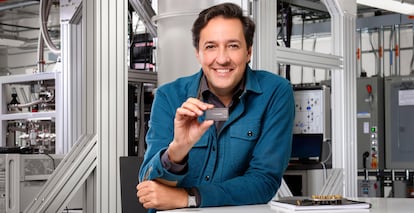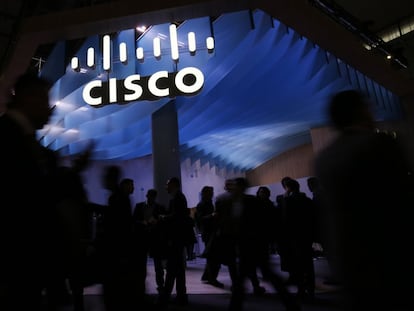Darío Gil, head of IBM Research: ‘Our vision is for people to benefit from the quantum world without needing to know anything about it’
The company recently unveiled its latest achievement: the new 433-qubit ‘Osprey’ processor, with a vastly greater computational capability than a classical computer

Darío Gil, 47, is Senior Vice President at IBM and the company’s Director of Research. He heads a department that is developing quantum computing, hailed as the 21st century’s most disruptive technology. So far, the goals of the department’s development roadmap are being met on time and “even ahead of schedule,” notes the Spanish-born engineer, who this week unveiled the company’s latest achievement: the new 433-qubit ‘Osprey’ processor, more than triple the 127 qubits on the IBM Eagle processor unveiled in 2021, and with a vastly greater computational capability than a classical computer. As an example, researchers explain that “the number of classical bits that would be necessary to represent a state on the IBM Osprey processor far exceeds the total number of atoms in the known universe.”
IBM’s quantum systems have the backing of hundreds of companies that are working side by side with the multinational to find applications for a technology that could unravel the origin of the universe and open up new doors for humanity to develop medication, create new materials and shape the future of energy.
Question. What is the relevance of having reached 433 qubits with Osprey?
Answer. We are experiencing the development of quantum computing and the creation of an industry. In order to advance with the technology, you need to create a community that will create value for all the parties involved. At IBM we are guided by our roadmap, which we shared with the industry two years ago, and on that roadmap we established the evolution of quantum computing. The first processor we put on the cloud, in May 2016, had five qubits; last year we were up to 127, now we have advanced to 433 and next year there will be one with over 1,000. Besides that, we drew a software trajectory of how it would evolve. Our vision for quantum computing is to make it frictionless, so that you don’t need to know anything about the quantum world, other than the fact that it exists, to benefit from it. Osprey proves that we are executing our roadmap. The biggest chip in the world was Eagle’s with 127 qubits, but now, with 433, there is nothing like it in the world of supercomputers.
Q. What about the claim about a greater computational capability than there are atoms in the known universe?
A. The power of quantum computing is linked to how to represent information in the richest possible way. The number of states available in a quantum computer begins at 2n, where n is the number of qubits. If you have 2^100 qubits, there are more states that atoms in our planet. And if you take it to 300 qubits, that’s more than in the entire universe. Even if you devoted all the atoms in the universe to storing 0s and 1s, you wouldn’t have enough. That is where you see the exponential power of quantum computing.
Q. What are the frontiers of quantum computing?
A. There are three important vectors: one is the number of qubits; another is their quality, and the third is the speed of execution. This year we multiplied the number of qubits by three, the quantum volume (quality) by four, and the speed of execution of circuits by 10. These are very significant numbers that show how we are progressing.
Q. Does the Osprey allow us to speak of quantum supremacy, seeing as how it is a processor capable of performing tasks that cannot be executed by any classical computer in a reasonable amount of time?
A. I don’t like that concept, as everyone knows. What we are trying to achieve is a sustainable quantum advantage. That means the combination of enough qubits, quality and speed to conduct a more effective computation on a relevant problem in science or business than with a classical computer. The first advantage is that quantum computers can no longer be simulated. We have created new systems that can no longer be emulated efficiently with a classical computer. But the great frontier for the next few years is to ensure that these systems, through error suppression and mitigation, as well as quality execution speed, will achieve a result that could not be achieved as effectively with a classical computer. We are making enough progress and I hope it will happen in the next couple of years.
Q. Will the issue of errors be resolved?
A. When we put the first computer on the cloud, it had two or three errors for every 100 operations. Now, with the more advanced systems, we have achieved one error for every 1,000 operations. We need to reach one for every 10,000. If we can manage that with adequate coherence levels, the time before a qubit becomes a bit, that cocktail, together with algorithmic error correction and mitigation will enable the first demonstration of the quantum advantage.
Q. Can the scientific community use Osprey?
A. We will make it accessible within the IBM Quantum Network to our customers and partners starting early next year. There are already more than 200 institutions in the Quantum Network, from large enterprises to labs, universities and strategic partners around the world.
Q. What is quantum computing being used for?
A. There are three main categories where it is being developed. The first has to do with simulating everything that has to do with nature. In the industrial sector, companies such as Boeing are modeling materials to give them the best properties. Others, such as BP, are using it in energy, and Daimler is working on batteries. In other words, everything that depends on materials, physics and chemistry. The second area is data that has a structure. It is the basis of cryptography or machine learning. This mathematical basis is very horizontal. For example, one sector that is highly involved is the financial sector. Quantum computing teams are being formed within companies to explore uses and we are giving them access to the best systems. And there are also almost 2,000 scientific publications that have been generated using IBM computers. It has become a premier scientific tool. Qiskit, the world’s most popular Open Source quantum community, has 1.8 million downloads for developing quantum applications. Ever since we launched the first systems in 2016, we have seen how the sector has become an industry that is already among the five major technological priorities of the vast majority of developed countries. The industrial fabric is moving forward. We have set up quantum computing centers in the United States, Germany, Japan, South Korea, Canada....
Q. What about Spain and Latin America?
A. It will happen. I’ve always had a great desire to do it, but these things take time. I am convinced that it will happen and it will not be in the long term. In Spain and throughout Latin America there is extraordinary talent and a very high level of interest. It is a priority and, as far as I am concerned, nothing would be more exciting.
Q. Has the key to success at IBM been to advance quantum computing without neglecting classical computing?
A. They are complementary. The revolution in the world of computing that we are experiencing is the most exciting moment since the first digital systems were created in the 1940s. The new revolution is more than about qubits. It is the combination of bits, neural networks and qubits. Bits representing high-precision computing, the neural networks that form the basis of AI [artificial intelligence] and quantum bits. The key is to combine them. It will always be a hybrid system of classical and quantum information. Orchestration is the key to the future. Osprey’s design is based on that modularity so that we can have multiple chips together with thousands of qubits in the future by combining multiple systems. We are already designing systems that will have tens of thousands of qubits. We’ve seen supercomputing systems based on CPUs [central processing units] and, in the last decade, supercomputers based on GPUs [AI accelerators]. Now we’re going to create computing systems where we’ll add to those two quantum processors. The recently announced IBM Quantum System Two is our vision of creating the first quantum supercomputers. To achieve this goal, we are going to be pioneers in bringing together the fields of quantum computing and quantum communication. We are going to create quantum entanglement of qubits that are on different chips and even systems. For the latter, we have to invent what is called a transducer, which would allow us to go from 5 GHz to terahertz optical frequencies. We are working simultaneously on today, tomorrow and 10 years from now.
Tu suscripción se está usando en otro dispositivo
¿Quieres añadir otro usuario a tu suscripción?
Si continúas leyendo en este dispositivo, no se podrá leer en el otro.
FlechaTu suscripción se está usando en otro dispositivo y solo puedes acceder a EL PAÍS desde un dispositivo a la vez.
Si quieres compartir tu cuenta, cambia tu suscripción a la modalidad Premium, así podrás añadir otro usuario. Cada uno accederá con su propia cuenta de email, lo que os permitirá personalizar vuestra experiencia en EL PAÍS.
¿Tienes una suscripción de empresa? Accede aquí para contratar más cuentas.
En el caso de no saber quién está usando tu cuenta, te recomendamos cambiar tu contraseña aquí.
Si decides continuar compartiendo tu cuenta, este mensaje se mostrará en tu dispositivo y en el de la otra persona que está usando tu cuenta de forma indefinida, afectando a tu experiencia de lectura. Puedes consultar aquí los términos y condiciones de la suscripción digital.
More information
Últimas noticias
Most viewed
- Oona Chaplin: ‘I told James Cameron that I was living in a treehouse and starting a permaculture project with a friend’
- Reinhard Genzel, Nobel laureate in physics: ‘One-minute videos will never give you the truth’
- Sinaloa Cartel war is taking its toll on Los Chapitos
- Why the price of coffee has skyrocketed: from Brazilian plantations to specialty coffee houses
- Silver prices are going crazy: This is what’s fueling the rally










































